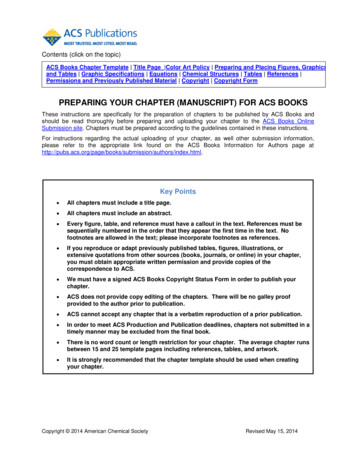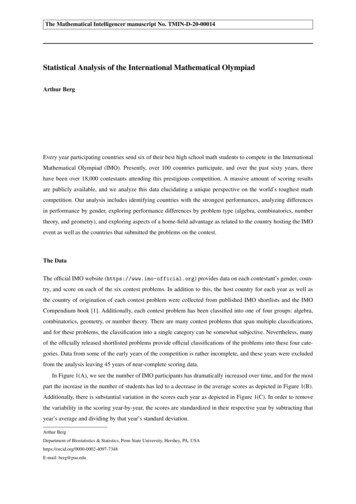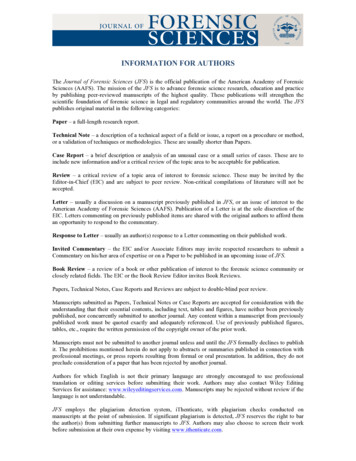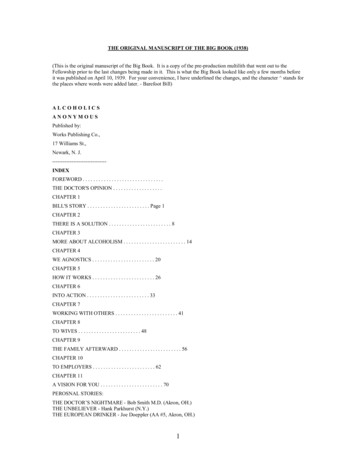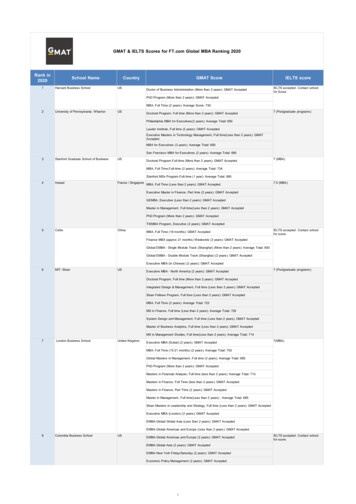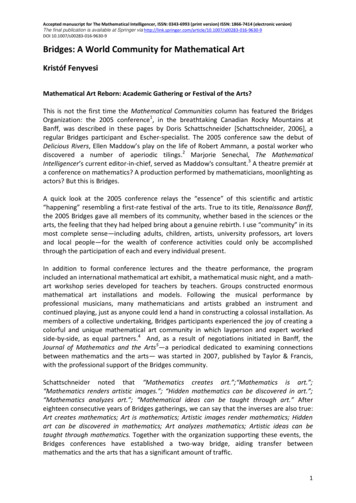
Transcription
Accepted manuscript for The Mathematical Intelligencer, ISSN: 0343-6993 (print version) ISSN: 1866-7414 (electronic version)The final publication is available at Springer via 6-9630-9DOI 10.1007/s00283-016-9630-9Bridges: A World Community for Mathematical ArtKristóf FenyvesiMathematical Art Reborn: Academic Gathering or Festival of the Arts?This is not the first time the Mathematical Communities column has featured the BridgesOrganization: the 2005 conference1, in the breathtaking Canadian Rocky Mountains atBanff, was described in these pages by Doris Schattschneider [Schattschneider, 2006], aregular Bridges participant and Escher-specialist. The 2005 conference saw the debut ofDelicious Rivers, Ellen Maddow’s play on the life of Robert Ammann, a postal worker whodiscovered a number of aperiodic tilings.2 Marjorie Senechal, The MathematicalIntelligencer’s current editor-in-chief, served as Maddow's consultant.3 A theatre premiér ata conference on mathematics? A production performed by mathematicians, moonlighting asactors? But this is Bridges.A quick look at the 2005 conference relays the “essence” of this scientific and artistic“happening” resembling a first-rate festival of the arts. True to its title, Renaissance Banff,the 2005 Bridges gave all members of its community, whether based in the sciences or thearts, the feeling that they had helped bring about a genuine rebirth. I use “community” in itsmost complete sense—including adults, children, artists, university professors, art loversand local people—for the wealth of conference activities could only be accomplishedthrough the participation of each and every individual present.In addition to formal conference lectures and the theatre performance, the programincluded an international mathematical art exhibit, a mathematical music night, and a mathart workshop series developed for teachers by teachers. Groups constructed enormousmathematical art installations and models. Following the musical performance byprofessional musicians, many mathematicians and artists grabbed an instrument andcontinued playing, just as anyone could lend a hand in constructing a colossal installation. Asmembers of a collective undertaking, Bridges participants experienced the joy of creating acolorful and unique mathematical art community in which layperson and expert workedside-by-side, as equal partners.4 And, as a result of negotiations initiated in Banff, theJournal of Mathematics and the Arts5—a periodical dedicated to examining connectionsbetween mathematics and the arts— was started in 2007, published by Taylor & Francis,with the professional support of the Bridges community.Schattschneider noted that “Mathematics creates art.”;“Mathematics is art.”;“Mathematics renders artistic images.”; “Hidden mathematics can be discovered in art.”;“Mathematics analyzes art.”; “Mathematical ideas can be taught through art.” Aftereighteen consecutive years of Bridges gatherings, we can say that the inverses are also true:Art creates mathematics; Art is mathematics; Artistic images render mathematics; Hiddenart can be discovered in mathematics; Art analyzes mathematics; Artistic ideas can betaught through mathematics. Together with the organization supporting these events, theBridges conferences have established a two-way bridge, aiding transfer betweenmathematics and the arts that has a significant amount of traffic.1
Accepted manuscript for The Mathematical Intelligencer, ISSN: 0343-6993 (print version) ISSN: 1866-7414 (electronic version)The final publication is available at Springer via 6-9630-9DOI 10.1007/s00283-016-9630-9From its beginnings in 1998, Bridges has advocated for mathematics as a core component ofSTEM (Science, Technology, Engineering, Mathematics) education. Years before the STEMacronym was even created [Christenson, 2011] and spread, Bridges had humanized it. TheBridges community has never had to expand its approach from STEM to STEAM (Science,Technology, Engineering, Arts and Mathematics): it has always included those aspects of thearts, design, creative thinking and artistic imagination so very necessary to, yet still so verylacking from many STEM projects today. From its inception Bridges has given the STEAMmovement inspiration for a transdisciplinary and intercultural platform.Figure 1: A colorful group of Bridges participants in front of the Gossamer Zometool model, amassive sculptural tribute to the late architectural visionary, Jean Christoph Kling, at theBridges 2009 “Renaissance Banff II.” conference. Five meters in diameter and assembledfrom 50,000 Tinkertoy-like parts, the gossamer model was the largest of its type everattempted. 150 mathematicians and artists from all over the world and several of theirchildren were assembling the small plastic Zometool components into superstructures thatbecame the final sculpture. The work took more than 250 person-hours, performed duringbreaks between presenting and attending talks. Although the model is built entirely frompoints and straight lines (i.e., nodes and struts) the model looks like a 3-dimensional“spirograph” drawing, with organic curves that mimic life forms. The underlying structure isderived from a shadow of a 6-dimensional cube. Photo: Carlo H. Séquin.2
Accepted manuscript for The Mathematical Intelligencer, ISSN: 0343-6993 (print version) ISSN: 1866-7414 (electronic version)The final publication is available at Springer via 6-9630-9DOI 10.1007/s00283-016-9630-9From the “Persian Paradigm” to STEAM and Back Again: the Inception of BridgesThe first few Bridges conferences were hosted by Southwestern College in Winfield, Kansas.How did this small town college, not known for its contributions to the art and sciencediscourse, assume this role?As is often the case with active and successful communities and networks, Bridges wasbegun by a many-sided individual with contacts in both science and culture. When RezaSarhangi emigrated to the United States from Iran in 1986, at the start of his mathematicalcareer, he brought with him the qualities associated with STEAM integration today. Hisbroad range of personal interests as well as his research into ancient Persia’s mathematicalpast helped him direct attention to mathematics’ complex cultural roots. His work as auniversity teacher in education was defined by these goals as well. For his integrationalapproach to mathematics and art, Sarhangi looked far beyond the well-known works ofartists such as M.C. Escher [Sarhangi and Martin, 1998.] to the joint efforts of mathematicand artistic communities in ancient times.Mathematics, arts and crafts coexised side-by-side during the medieval period of Persianhistory.6 Sarhangi has continuously emphasized the work of Abul Wafa al-Buzjani (940997/998), one of the most famous mathematicians of his time. Al-Buzjani’s treatise, OnThose Parts of Geometry Needed by Craftsmen, was written to educate craftspeople ingeometry. For medieval craftspeople, creating the decorative motifs common to the Persianart of this era demanded not only constant training, but also regular consultation withmathematicians. Indeed, decorating the inner as well as outer, spherical surface of cupolawith tiles featuring highly regular, yet still extremely complex geometric patterns wouldhave required advanced knowledge of geometry. The sophisticated, mathematical nature ofPersian decorative arts not only makes them interesting from a historical perspective, butalso provides a fascinating area of research for mathematicians today.7Before emigrating to the United States, Sarhangi was more than a teacher of mathematicsinterested in Persian traditions. He was a graphic artist, teacher of drama, playwright,theatre director and props designer. When added to his background in mathematics andhistory, his first-hand experience of complex and collective artistic processes—such ascreating and performing a theatrical play—gave him deep insight into the equally complexprocesses involved in designing and producing medieval Persian tilings. Sarhangi made gooduse of his many areas of expertise, first as an innovative, young university professor open tonew experiments, then later on as an educator of math instructors. As department chair ofSouthwestern College’s Department of Mathematics, he already introduced creative studymodules or theatrical plays on mathematics to change how mathematicians were educated.In his new country Sarhangi looked for the kind of academic community capable ofsupporting his broad range of interests. In the early 1990s, the college implemented a newIntegrative Studies Program that drew together faculty from all other traditional and3
Accepted manuscript for The Mathematical Intelligencer, ISSN: 0343-6993 (print version) ISSN: 1866-7414 (electronic version)The final publication is available at Springer via 6-9630-9DOI 10.1007/s00283-016-9630-9professional programs. As director of the Integrative Studies Program, Daniel F. Daniel,Sarhangi's close friend and mentor at Southwestern, suggested that Sarhangi establish anew course for this program. His course on connections between mathematics and the artsbecame very popular among students.Sarhangi also attended the Art and Mathematics (AM) conferences organized by NatFriedman at the State University of New York at Albany from 1992 to 1998, which openedtheir doors to artists, architects, and other experts applying mathematics creatively. Thespirit of cooperation engendered by these AM gatherings led to the publication of severalinterdisciplinary papers uniting different perspectives to form a kaleidoscope-like vision ofthe given topic. With some exaggeration, it can be said that Sarhangi felt he was witnessingthe rebirth of a long-forgotten paradigm from Abul Wafa al-Buzjani’s time. He could seefirst-hand how a new form of art arises from the dialogue between the mathematiciancreating the theories for solving complex artistic or architectural problems, and the masterputting theories into practice. This art possesses a unique, aesthetic quality all its own,whose analysis demands a new approach, a kind of “interdisciplinary aesthetics” bothmathematical and artistic in nature.8Known as ISAMA (International Society of the Arts, Mathematics, and Architecture)9 as of1998, the AM movement was the direct, American antecedent to the later Bridgesconferences. Indeed, three of Bridges’s first four directors: George Hart10, Carlo Séquin11and Reza Sarhangi were ISAMA veterans. The fourth director, Craig S. Kaplan12, started hiscareer in mathematical art in 1999 after joining the ISAMA and Bridges communties and coorganizing the MOSAIC 2000 conference, which examined connections between computerprogramming and the arts. Robert W. Fathauer13 soon assumed responsibility for organizingthe Bridges art exhibits.144
Accepted manuscript for The Mathematical Intelligencer, ISSN: 0343-6993 (print version) ISSN: 1866-7414 (electronic version)The final publication is available at Springer via 6-9630-9DOI 10.1007/s00283-016-9630-9Figure 2: Bridges would not exist without them. Bridges Organization’s founders RezaSarhangi (right), Sarhangi’s wife Mehri Arfaei (middle) and Carlo H. Séquin (left). Photo bycourtesy of Reza Sarhangi.Many groups and “schools” have connected to form the background for the American,European and Asian science and art communities currently involveld in the BridgesOrganization. These include the Mathematics and Culture conferences [Emmer, 2004-2012,2012-2014, 2015], the Nexus conferences,15 and the Symmetry Festivals16 begun by GyörgyDarvas and Dénes Nagy in 1989 in Budapest, Hungary. The increasingly active presence ofthe European Society of Mathematics and Arts17 also deserves mention. Bridges also enjoysa close-knit relationship with the International Mathematics & Design Association located inBuenos Aires, established by the mathematician, Vera W. de Spinadel, in 1998. TheMathematical Association of America’s Special Interest Group on Mathematics and the Arts(SIGMAA-ARTS) was established by Bridges members and participants, and currently hasmore than 200 members.18Inter- and Transdisciplinarity: Bridges as a “World View”The nearly 300-page proceedings from the first Bridges conference19 was reviewed in NexusNetwork Journal by the mathematician, Solomon Marcus, a pioneer in numerousinterdisciplinary as well as transdisciplinary areas related to mathematics [Marcus, 1999].He called for the further broadening and deepening of artistic analysis within the newly5
Accepted manuscript for The Mathematical Intelligencer, ISSN: 0343-6993 (print version) ISSN: 1866-7414 (electronic version)The final publication is available at Springer via 6-9630-9DOI 10.1007/s00283-016-9630-9emerging, Bridges discourse to include, for example, connections between mathematics andpoetry. The Bridges Organization has followed his suggestions. Year by year, as exhibitsincreasingly put new mediums of mathematical art on display, conference lectures openthese works to further analysis. The movement’s tendency to refine its themes inspires newprogram elements, such as the Bridges Poetry Afternoons organized by Sarah Glaz.20Marcus noted that “[at the Bridges conferences] artists enlarge their creative horizon bylooking at the achievements of modern science, while scientists have a chance to see, in anew light, their own results.” [Marcus, 1999: 156.] And in fact many of the experiences andmoments reflected in this conference series demonstrate art’s ability to broaden thehorizons of science as well.21Probably the best evidence for the two-way traffic on Bridges' bridges is the manytransdisciplinary collaborations which grown from encounters between mathematicians andartists at Bridges-related events. For example Ars Geometrica Symposiums (2007-2009,Hungary)—which prepared the ground for Bridges 2010 in Hungary—led to the internationalrecognition of the mathematical artworks of sculptor István Böszörményi [Gailiunas 2007]and also sparked Böszörményi’s still on-going collaboration with the renownedmathematician Lajos Szilassi, whose “Szilassi-polyhedron” was noted and popularized byMartin Gardner [Gardner, 1978]. Szilassi’s mathematical theories and models have inspiredthe sculptor Böszörményi's art [Böszörményi 2013]. Artists also have fruitfully inspiredmathematical research, as the case of the mathematician László Vörös and the artist TamásF. Farkas shows [Vörös 2011].Figure 3 a, b: Hungarian sculptor, István Böszörményi and some of his mathematicalartworks based on his collaboration with the mathematician, Lajos Szilassi6
Accepted manuscript for The Mathematical Intelligencer, ISSN: 0343-6993 (print version) ISSN: 1866-7414 (electronic version)The final publication is available at Springer via 6-9630-9DOI 10.1007/s00283-016-9630-9Figure 4 a, b, c: László Vörös’ mathematical reconstruction of Victor Vasarely’s Duo-2, 1967(left), and Tamás F. Farkas’ impossible figure (middle) based on the same method [cf. Vörös2011], and Farkas’ original artwork (right), which inspired Vörös’ research.From its beginning, Bridges has broken with the monotony of traditional conferencelectures. The goal was to bring research alive, have it on display—or even put it on stage.Mathematician Mike Field—co-author of Symmetry in Chaos [Field and Golubitsky, 2009]described his experiences at the second and third Kansas conferences: “At the Winfieldconferences, the international virtuoso violinist Corey Cerovsek played for the audienceafter plenary sessions in the morning, often preceding his performance with an extemporetalk on a topic from physics or mathematics (concurrently with his musical studies, Coreycompleted all the coursework for a Ph.D. in mathematics when he was about sixteen). Asidefrom the music, there would usually be theater shows as well as teacher workshops, held atthe end of the conference. [ ] I [ ] can testify to the great atmosphere of these meetings,where artists, mathematicians, computer scientists, and educators would talk into the earlyhours.” [Field, 2006: 730.] Reza Sarhangi draws on his past in theatre to evoke thepersonable atmosphere and wealth of experiences at these first gatherings: “Theatreinvolves making connections with the audience that go beyond just the script [ ] So atBridges, I – and the other three board members – want the conference attendees to getmore than just the content of the papers, but to have an enjoyable experience thatintegrates art, dance, and other performances.” [Crease, 2014: 17.]7
Accepted manuscript for The Mathematical Intelligencer, ISSN: 0343-6993 (print version) ISSN: 1866-7414 (electronic version)The final publication is available at Springer via 6-9630-9DOI 10.1007/s00283-016-9630-9Figure 5 a, b, c: “Worldsand” (Sammlung Weltensand) composition at Bridges 2010 by ElviraWersche, who collects different types and colours of sand from all over the world and uses itto construct complex mosaics, composed of geometrical patterns, on the floors of museums,churches and synagogues. When the artwork was finally ready, a dancer literally erased thecarefully constructed pattern. By doing so, the artist emphasized that everything is inconstant flux and everything is only temporary. Photos: László Mihály.8
Accepted manuscript for The Mathematical Intelligencer, ISSN: 0343-6993 (print version) ISSN: 1866-7414 (electronic version)The final publication is available at Springer via 6-9630-9DOI 10.1007/s00283-016-9630-9Bridges around the WorldBarely sixty participants attended the first Bridges conferences; today they attract annuallyaround 250-300 conference participants from around the globe and thousands of people inthe audience. Since Sarhangi moved from Winfield to Towson, Maryland, in 2002, theBridges Organization – a Scientific and Educational Non-Profit Corporation established in theState of Maryland in 2006 – has handled the administrative tasks related to these events.The resounding success of Bridges 2003 in Granada, Spain (organized together with ISAMA)-- in the shadow of the Alhambra, one of the greatest math-art works in history—promptedthe organizers to hold future conferences in tourist destinations, and include thematic daytrips. Bridges conferences have been held in Winfield, USA (1998-2001); Towson, USA(2002) ; Granada, Spain (2003); Winfield, USA (2004); Banff, Canada (2005); London, UK(2006); San Sebastian, Spain (2007); Leeuwarden, The Netherlands (2008); Banff, Canada(2009); Pécs, Hungary (2010); Coimbra, Portugal (2011); Towson, USA (2012); Enschede, TheNetherlands (2013); Seoul, Korea (2014); and Baltimore, USA (2015). In 2016 Bridges willembark on its first Nordic conference, held at the University of Jyväskylä in Finland, themost northern location ever to host a Bridges event.22Figure 6: Invitation postcard for Bridges Finland 2016, hosted by the University of Jyväskylä.9
Accepted manuscript for The Mathematical Intelligencer, ISSN: 0343-6993 (print version) ISSN: 1866-7414 (electronic version)The final publication is available at Springer via 6-9630-9DOI 10.1007/s00283-016-9630-9Once its community took to globe-trotting, the Bridges conferences began generating aform of organized math-art tourism. But the intellectual benefits extend beyond theconferenece participants. Thanks to international media, the attention paid Bridgesevents—hosted by resident scientific and cultural institutions—strengthens local math-artcommunities. I can attest that the Experience Workshop Math-Art Movement,23 anindependent community of mathematicians, artists and educators, established in Hungary in2008 preceding the Bridges Pécs 2010 conference, is still growing. Through this movementtens of thousands of Hungarian students and thousands of teachers have been exposed tothe Bridges philosophy of experience-oriented mathematics education through the arts.Figure 7: Top scholars – George W. Hart (left) and Sujan Shrestha (right) on Bridges Seoul2014 conference excursion in the Korean mountains. Photo: Carlo H. Séquin.10
Accepted manuscript for The Mathematical Intelligencer, ISSN: 0343-6993 (print version) ISSN: 1866-7414 (electronic version)The final publication is available at Springer via 6-9630-9DOI 10.1007/s00283-016-9630-9Figure 8: Bridges directors George W. Hart, Reza Sarhangi, Craig S. Kaplan, Carlo H. Sequinand Kristóf Fenyvesi (left to right) listening the talk of Rubik’s cube’s inventor, Ernő Rubik atBridges Pécs 2010, Hungary. Photo: László Mihály.Participants, Goals and Events at Bridges ConferencesThe sheer diversity of topics and areas addressed at Bridges conferences draws a wideaudience of scholars and artists. 24 In addition to mathematicians, scientists, art andeducation experts, they attract painters, teachers, musicians, architects, literary scholars,computer programmers, sculptors, dancers, craftspeople and model builders.11
Accepted manuscript for The Mathematical Intelligencer, ISSN: 0343-6993 (print version) ISSN: 1866-7414 (electronic version)The final publication is available at Springer via 6-9630-9DOI 10.1007/s00283-016-9630-9Figure 9: Dr. Schaffer and Mr. Stern Dance Ensemble’s performance at Bridges 2010. Photo:László Mihály.Each conference reflects many different aspects. Bridges presents a platform for scholars,experts and artists intent upon pushing boundaries and exchanging experiences. Beyondsupplying professional support, it encourages mathematics teachers to utilize creative,artistic processes and tools in passing on mathematical knowledge, and art teachers toreveal the mathematics involved in certain artworks or artistic processes. The educationalrelevance of math-art approaches has been demonstrated in interactive, experienceoriented workshops since Bridges’s early days. Works of art are displayed in math-artexhibits, not just discussed in conference lectures. The Bridges collection has since grown tobe the largest exhibit of mathematical-art in the world. Throughout the years, creativeprograms have become increasingly structured and have now evolved into separate areas ofexpertise directed by skilled professionals. The key elements, which form the backbone ofany Bridges event (such as the plenary and section lectures, education and fun workshops,mathematics and art short movie festival, the mathematical art exhibit, the mathematicaltheatre show, music night, family day, poetry afternoon, and public events) can be studiedon the Bridges Organization’s website, where each year’s program is archived.2512
Accepted manuscript for The Mathematical Intelligencer, ISSN: 0343-6993 (print version) ISSN: 1866-7414 (electronic version)The final publication is available at Springer via 6-9630-9DOI 10.1007/s00283-016-9630-9Figure 10: Artists, mathematicians and their mathematical artworks at Bridges 2010 ArtExhibit, curated by Robert Fathauer. Photo: László Mihály.Bridges’ transdisciplinary program has elaborated new transdisciplinary standards and hasproductively solved a high number of unforeseenable and unprecedented challenges. Theseare risks run by any truly transdisciplinary venture; they may never emerge in relativelyhomogeneus scientific or artistic communities with established traditions and history.For example, Bridges has struggled to balance the openness of the conference and withacademic legitimacy. In the beginning, Bridges conferences were highly inclusive; everybodywho wanted to would have an opportunity to share their work. This model works indisciplines where journals are the true coin of the realm and conferences are just a chanceto present work in progress to colleagues. But it can be problematic for participants fromother disciplines—like Bridge's director Craig Kaplan’s own field, Computer Science—, whowant to assign significant weight to conference papers: “I think one of my influences hasbeen to fight in favour of higher standards for regular papers, stricter peer reviewpractices," Kaplans says. "Of course, it helped to set up online tools that streamlined themechanics of reviewing so that we could focus on the quality. I think we've done a decentjob of compensating for these changing standards by ensuring there are lots of other forumsin which participants can present their work at the conference.”13
Accepted manuscript for The Mathematical Intelligencer, ISSN: 0343-6993 (print version) ISSN: 1866-7414 (electronic version)The final publication is available at Springer via 6-9630-9DOI 10.1007/s00283-016-9630-9The polyphonic nature of Bridges conferences requires an organic and open universe ofpolyphonic standards to ensure that each contribution will be judged according to thehighest standards of its own field. If there is a new kind of need in the community, then anew platform is created for it. Different juries review the submissions for the art exhibitsand the short film festival and there is a transdisciplinary program committee for reviewingthe conference papers representing a multitude of scientific and artistic research fields.Bridges has always had a core community of participants who make up the “choir”. “Andsure, we preach to them,” admits Kaplan. He believes that designing a conference to appealto its long-term supporters will make it better overall. But, like Bridges president RezaSarhangi, Kaplan thinks that Bridges has done a good job of bringing in new faces, newvoices, and new ideas every year. Bridges is increasingly offering itself as a public face formathematics, a way to make it accessible to the general public. This was perhaps mostsuccessful in 2014, where Bridges was invited to Seoul by the International Congress ofMathematicians (ICM) to serve as a public counterpoint to the ICM happening across thecity. Yet many mathematicians still don't see the special value in Bridges’ polyphonicdifference. “We need a stronger voice outside of Bridges itself. The Joint MathematicsMeetings (JMM) art exhibit and JMM math and art session are our attempts to reach othersin the US in mathematics”, Sarhangi says.Figure 11: Dozens of fun activities at Bridges Family Day. Photo: László Mihály.14
Accepted manuscript for The Mathematical Intelligencer, ISSN: 0343-6993 (print version) ISSN: 1866-7414 (electronic version)The final publication is available at Springer via 6-9630-9DOI 10.1007/s00283-016-9630-9Bridges to the Future: the Next GenerationToday, as changes in the world bring about unseen alterations in the structure ofknowledge, any form of research, learning, or creativity capable of heightening awarenesstoward interlocking systems possesses untold value. First and foremost, knowledge such asthis allows one to preserve a sense of exploration and inquiry, elements essential to allrational and creative activities. Without these, the ability to recognize those patterns andtrends dictating current changes is lost.Figure 12: Girls playing with Gábor Gondos Bridges participant’s math-art puzzle. Photo:László Mihály.The first mathematical museum in the United States, MoMath,26 was established in NewYork City to connect seemingly disparate phenomena while simultaneously encouragingcreative and imaginative opportunities in math education for children and young adults. Asone of the founding members of this internationally unique institute, George W. Hart notonly adapted the Bridges community’s STEAM-approach, but also the work of manydistinguished Bridges members to this special, interactive setting.Bridges Organization has combined forces in organizing the MoSAIC (Mathematics ofScience, Art, Industry and Culture)27 event series, sponsored by the Mathematical SciencesResearch Institute (MSRI) to spur STEAM approach among young people. As a part of thisprogram, popular aspects of Bridges events are held at university campuses throughout the15
Accepted manuscript for The Mathematical Intelligencer, ISSN: 0343-6993 (print version) ISSN: 1866-7414 (electronic version)The final publication is available at Springer via 6-9630-9DOI 10.1007/s00283-016-9630-9USA. MoSAIC’s astounding success and a new generation in the Bridges community suggestwe have every reason for confidence.ACKNOWLEDGEMENTSThanks to the Bridges Board of Directors for their information, to Maya Tóth, and to OsmoPekonen and to my colleagues in the Bridges Finland 2016 Local Organizing Committee atthe University of Jyväskylä.University of JyväskyläJyväskylä, Finlande-mail: fenyvesi.kristof@gmail.comKristóf Fenyvesi, PhD – researcher of STEAM Learning and Contemporary Cultural Studies atUniversity of Jyväskylä, Department of Art and Culture Studies; member of the BridgesOrganization’s Board of Directors, Director of Community Events; Chief Executive Officer ofInternational Symmetry Association; Director of Experience Workshop International MathArt Movement.REFERENCESBelting, Hans. Florence and Baghdad: Renaissance Art and Arabic Science, Cambridge, MA:Belknap, 2011.Böszörményi, István. “Klein-palackok síklapokból.” Ponticulus Hungaricus XVII. 3., 2013.March hidverok/boszeelte.html Christenson,Jerome. “Ramaley coined STEM term now used nationwide.”Winonadailynews.com,November13,2011. http://www.winonadailynew
Accepted manuscript for The Mathematical Intelligencer, ISSN: 0343-6993 (print version) ISSN: 1866-7414 (electronic version) The final publication is

